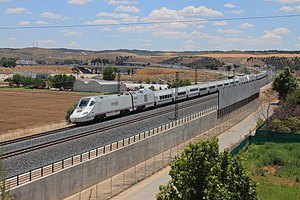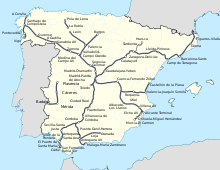
A tilting train is a train that has a mechanism enabling increased speed on regular rail tracks. As a train rounds a curve at speed, objects inside the train experience centrifugal force. This can cause packages to slide about or seated passengers to feel squashed by the outboard armrest, and standing passengers to lose their balance, or in such excessive speeds, could even cause the train to derail. Tilting trains are designed to counteract this by tilting the carriages towards the inside of the curve, thus compensating for the g-force. The train may be constructed such that inertial forces cause the tilting, or it may have a computer-controlled powered mechanism.

Talgo is a Spanish manufacturer of intercity, standard, and high-speed passenger trains. Talgo is an abbreviation of Tren Articulado Ligero Goicoechea Oriol.

A variable gauge system allows railway vehicles in a train to travel across a break of gauge between two railway networks with different track gauges. For through operation, a train must be equipped with special bogies holding variable gauge wheelsets which contain a variable gauge axle (VGA).
High-speed railways in Spain are in operation since 1992 when the first line was opened connecting the cities of Madrid, Córdoba and Seville. Unlike the rest of the Iberian broad gauge network, the Spanish High-speed network mainly uses standard gauge. This permits direct connections to outside Spain through the link to the French network at the Perthus Tunnel. High-speed trains run on a network of high-speed rail track owned and managed by ADIF, where the dominant service is AVE while other high speed services such as Avant, Alvia, Avlo, Euromed, Ouigo España and Iryo, as well as mid-speed (Altaria) services also operate.

The Renfe Class 100 is a high-speed train used for AVE services by the Renfe Operadora, in Spain. It was the first high-speed train put into service in Spain, in 1992.

The Renfe Class 102 or S-102 is a high-speed train used for the AVE service and operated in Spain by the state-run railway company Renfe, and based on Bombardier Transportation's power car technology. Outside AVE service, Talgo markets this train as the Talgo 350.

The Renfe 334 is a high speed, 4 axle diesel-electric locomotive built to haul passenger trains on Renfe's Talgo service on non electrified lines.

The Renfe Series 333 are high power six-axle diesel-electric locomotives built in the 1970s; at the time of their introduction they were the most powerful non-electric locomotives in Spain.
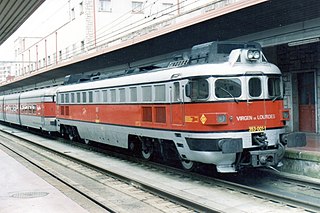
The Renfe Class 353, formerly known as the T-3000 are a class of diesel-hydraulic locomotives built by Krauss-Maffei for express trains in Spain.

The Renfe Class 352 was a class of twin engined four axle diesel-hydraulic locomotives built by Krauss-Maffei, designed solely for passenger traffic; in particular they were responsible for towing Andalusian Talgo III trains. The class were very successful, heralding a new era of passenger trains in Spain. They were delivered in 1964 and 1965, and were fully withdrawn during the 1990s.

The Renfe Class 354 was a series of eight diesel hydraulic locomotives manufactured by Krauss-Maffei in Germany specifically to pull Talgo pendular coaches which were introduced shortly before the acquisition of these machines.
Alvia is a high-speed train service in Spain offered by Renfe Operadora on long-distance routes with a top speed of 250 km/h (160 mph). The trains have the ability to use both Iberian gauge and standard gauge, which allows them to travel on the recently constructed high-speed lines for part of the journey before switching to the "classic" Iberian gauge network to complete it. Trains that run exclusively on high-speed tracks are branded AVE or Avant.

The Renfe Class 130 or S-130 is a high-speed dual-gauge, dual-voltage trainset consisting of 11 Talgo VII tilting coaches and two power cars, used on Alvia and Euromed services. The class have been nicknamed patitos (ducklings), due to the shape of the train nose.
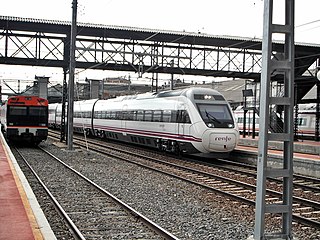
The Renfe Class 120 are electric multiple units used on Alvia high-speed rail services in Spain.

Talgo Avril is a high-speed train that Talgo is developing. It stands for "Alta Velocidad Rueda Independiente Ligero".

Oaris is a modular high-speed train platform developed by the Spanish manufacturer CAF.

The Catalan Talgo was an international express train that linked Geneva, Switzerland, with Barcelona, Spain from 1969 to 2010. It was named after the Spanish region Catalonia and the Talgo equipment it used. It was an extension and upgrading of a predecessor train, Le Catalan, a first-class-only French (SNCF) Rapide train that had been in operation since 1955 but running only between Geneva and the stations nearest the Spanish-French border, connecting with a second-class-only "autorail" trainset to and from Barcelona. The national railway network of Spain, Red Nacional de los Ferrocarriles Españoles (RENFE), was using Iberian gauge for all of its main lines, while those of France and Switzerland use standard gauge. As a result of this break-of-gauge, train journeys between Geneva and Barcelona consisted of two separate parts, with travelers having to change from a French to a Spanish train or vice versa at the border—at Portbou on southbound trains and at Cerbère on northbound trains. In 1968, this was resolved with the introduction of the Talgo III RD trainsets, which featured variable gauge wheelsets. At Portbou station, the wheel spacing of each passenger carriage was adjusted by a gauge changer for the difference in gauge, and passengers no longer had to change trains. After successful test runs, the Catalan was extended from Port Bou to Barcelona as a through train on 1 June 1969, becoming the Catalan Talgo and upgraded to a Trans Europ Express (TEE). Most other rail journeys through this border crossing continued to require a change of train at Cerbère station or at Port Bou, as most trains did not use Talgo III RD trainsets.
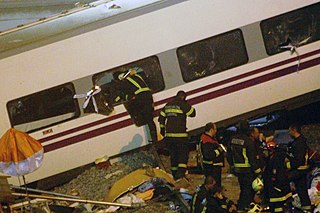
The Santiago de Compostela derailment occurred on 24 July 2013, when an Alvia high-speed train traveling from Madrid to Ferrol, in the north-west of Spain, derailed at high speed on a bend about 4 kilometres (2.5 mi) outside of the railway station at Santiago de Compostela. Of the 178 people injured, the provisional number of deaths in hospital had reached 79 by the following 28 July.

An electro-diesel multiple unit (EDMU) or bi-mode multiple unit (BMU) is a form of a multiple unit train that can be powered either by electric power picked up from the overhead lines or third rail or by using an onboard diesel engine, driving an electric generator, which produces alternating current (AC) or direct current (DC) electric power.
